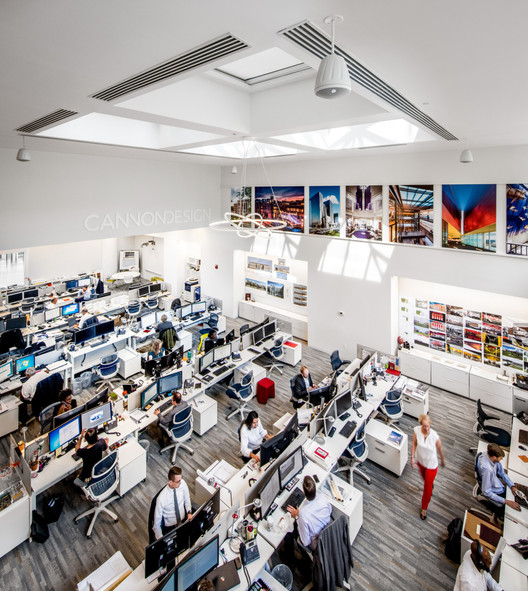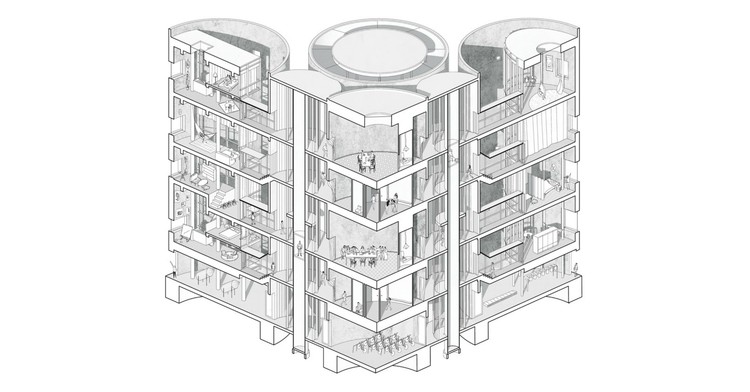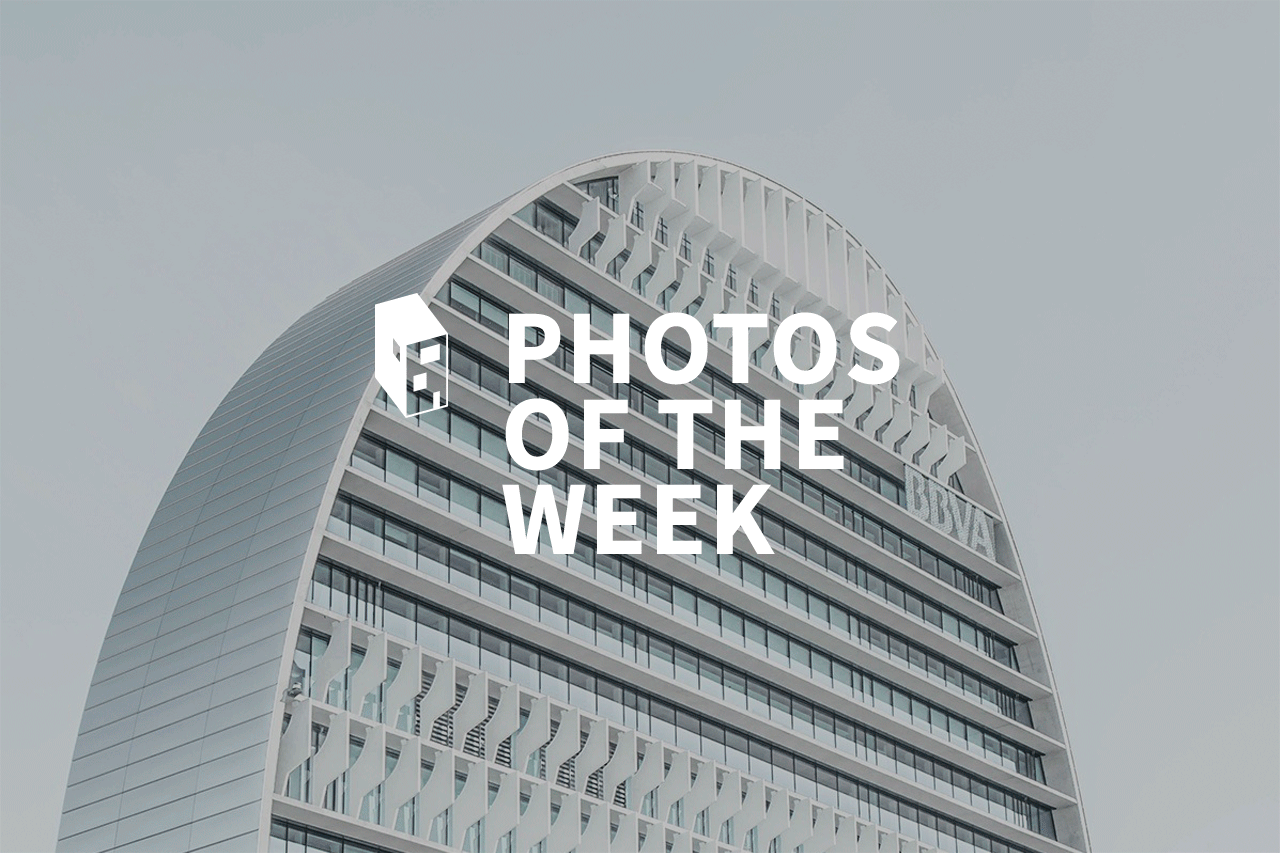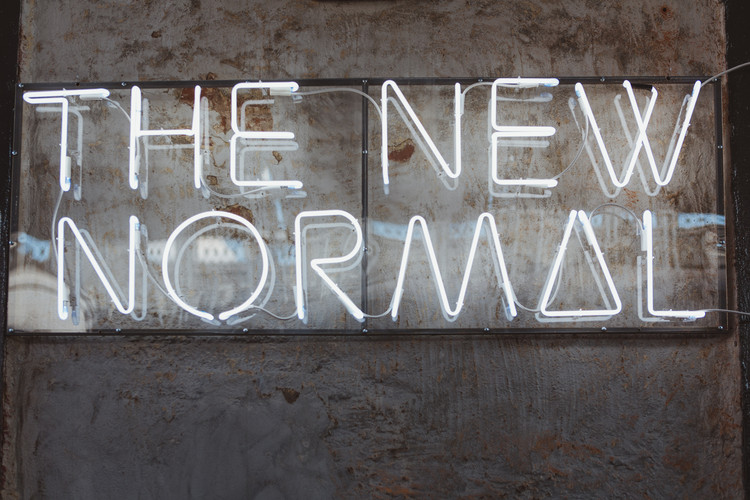
Creating a model for rendering does have its own set of rules. To get you up and rendering as quickly as possible, here are SketchUp's top five tips for prepping your SketchUp model for rendering.


Creating a model for rendering does have its own set of rules. To get you up and rendering as quickly as possible, here are SketchUp's top five tips for prepping your SketchUp model for rendering.

For the animal lovers among our audience, this week we have put together a special roundup of images of architecture alongside some marvelous critters. While not exactly a mainstay of architectural photography, proponents of the form like BoysPlayNice, Jesus Granada and Rafael Gamo have dared to include animal inhabitants in their architectural compositions. Read on to see a selection of 20 creative images where you will find horses, sheep, cows, goats, dogs, cats, and even elephants.

Like most architecture students, I heard the debate about whether it was better to work at a large or small design firm numerous times during my collegiate career. There are undoubtedly benefits offered by firms of each size, and you’ll find tons of people eager to discuss how the resources of a large firm can compare to the creative flexibility of a small firm and similar such discussions during your student journey. Truthfully, there’s no one best option or preferred path, but, with thousands of students set to head back to architecture or design school this fall, I wanted to share my perspective.
It was just a few years ago that I was in my final year of school and faced with a decision: what size firms should I pursue for my first job? There were numerous aspects of small firms that spoke to me, but ultimately, I chose the large-firm experience. Big offices, big projects, job security, the latest tech, modeling and 3D printed resources—this all sounded great to me. Two years in, I’ve found most of those benefits to ring true, but I’ve also uncovered several benefits I didn’t know I should have been looking for in the first place. These unplanned discoveries have made a significant difference in my day-to-day experience and in helping to kickstart my career. I thought it might be helpful to share them so other students can consider them when making their decision in 2018 and beyond.

The launch of a building in downtown São Paulo - Brazil was the talk of the town due to its surprising apartment sizes of only 10 square meters. This raised the debate about the market trend to produce ever smaller properties and the ability of these properties to meet the needs of its residents.
There is no doubt that, this type of real estate is related to newest trends of family compositions. It is increasingly common for residences to be occupied by only one person, or at most two. According to data from the SEADE Foundation for 2010, in the State of São Paulo, almost 40% of households have these characteristic, 13% of which is made up of a single resident.

The cloud-shaped bicycle terminal on the island of Naoshima is SANAA's latest work. The pavilion is known for its impressive collection of outdoor art and contemporary architecture, with works by prominent exponents such as Yayoi Kusama and Tadao Ando.
.jpg?1504871819)
For many young architects, studying abroad is a life-changing event in their development as a designer. It opens their eyes to a different culture, style, and history in a manner that no books or classes could explain. For that reason, architecture schools have been making study abroad easier and more ingrained in their curriculum. In addition to the study abroad opportunities offered by universities, there are many opportunities for students and recent graduates to travel and explore their own topic of study. Below is a list of 7 amazing grants and scholarships open to young architects and students:
.gif?1504720547)
Thirty years ago, on my first visit to India, I glanced over an ordinary wall. The ground fell away and was replaced by an elaborate, man-made chasm the length and depth of which I couldn’t fathom. It was disorienting and even transgressive; we are, after all, conditioned to look up at architecture, not down into it, and I had no clue as to what I was looking at. Descending into the subterranean space only augmented the disorientation, with telescoping views and ornate, towering columns that paraded five stories into the earth. At the bottom, above-ground noises became hushed, harsh light had dimmed, and the intense mid-day heat cooled considerably. It was like stepping into another world.
What might the futuristic home of Tony Stark (AKA Iron Man) look like in our more mundane world? In this fun exercise, Archilogic imagines a for-sale version the Malibu mansion. Explore it for yourself in the 3D model!
Ever dreamed of a real superhero lifestyle? We have a rare opportunity to buy in this secluded Malibu location, thanks to a change of heart by the former owner. Dramatic views, spectacular entertaining areas, plus a huge workshop/garage and helipad – it’s all here.
Lovingly rebuilt after an unfortunate accident, this stark white clifftop mansion once again has all its original features. Buyers who enjoy a rich social life will appreciate the glamorous history of the house, in which the celebrity former owner enjoyed a lavish party lifestyle, as much as its spectacular design.

This article was originally published by Common Edge as "It’s a Book. It’s a Building. It’s a Behavioral Intervention!"
A few years ago, while visiting, or rather exploring, Notre-Dame, the author of this book found, in an obscure corner of one of the towers, this word carved upon the wall:
'ANÁΓKH
These Greek characters, black with age, and cut deep into the stone with the peculiarities of form and arrangement common to Gothic calligraphy that marked them the work of some hand in the Middle Ages, and above all the sad and mournful meaning which they expressed, forcibly impressed the author.

In order for doctors to make a diagnosis, a patient needs to show symptoms. But what if the affliction in question isn’t an illness, but an extraordinary lifestyle? Almost everyone can agree that architecture brings with it a distinct way of living. The grueling hours, sharp design sensibilities and studio experience shape more than what we make – they define who we are as people. Architecture’s quirks and eccentricities become our adopted quirks and eccentricities. When it comes to spotting an architecture student on campus, it’s more than our clothes that give us away. Comic illustrators The Leewardists have drawn up some classic symptoms that serve as dead giveaways – check them out below:

Design juries undoubtedly form the very foundation of architecture school. Their success or failure, however, largely lies in the hands of the jurors who are assigned to review student work. While architecture is an inter-disciplinary subject with wide-ranging consequences, most jurors are specialists in a singular sub-field. This makes design juries a terrifyingly unpredictable affair; students don’t just battle against their nerves and sleep-deprivation, but are also required to be on their toes to ensure that they can handle anything that the jurors might throw at them.
However, this is easier said than done. As a student, defending your work against criticism from an easily-offended know-it-all juror will probably do you more harm than good. Similarly, it’s hard to impress a building services expert by harping on about the probable positive sociological impacts of your design proposal. Being able to correctly identify the academic or emotive leanings of a juror can go a long way in helping students present their work strategically, thus ensuring that they make the most of their jury experience. Here’s a compilation of nine types of design jurors every architecture student will probably face at some point in school:

High strength, ease of transport, and simplicity of assembly are among the many major advantages of steel. But while utilitarian steel structures tend to be hidden by architects, working with exposed steel can lead to attractive results. Steel not only brings lightness to a design, but can also offer different expressions of color and texture, depending on the treatment of the material. Below we present a selection of 14 photos of steel architecture from well-known photographers such as Adrien Williams, Imagen Subliminal, and Sergio Pirrone.

Shipping container architecture has developed its own niche in both design and representation. Colorful or grungy? Economical or gentrified? Either way, you look at it, designing with shipping containers is a serious exercise in modular planning. The physical constraints of the object make designing projects with containers a complex task, which demands specific studies in spatial organization.
The responses using this element in architecture are great and diverse, so we have selected a number of different project plans, both helpful and inspirational, that rise to the shipping container-challenge of design.
Check out selection of 10 architectural project plans using shipping containers below:
Only three of the Arts & Architecture Case Study Houses were built outside Los Angeles, and those three formed a united concept. The Triad Houses in La Jolla, a seaside suburb of San Diego, share a single driveway, motor court, and design vocabulary, while being created to meet different needs.
In keeping with the Case Study mission, all three houses used open-plan design, affordable modern materials (such as aluminium and concrete with wood frames), and plenty of glass to create a fresh and open mood. The emphasis was on strong geometric forms, careful detailing, horizontal lines (with perfectly flat roofs) and – this being the Californian coastline – dramatic views and outdoor living space, creating the illusion of more interior space than was actually present.

This article was originally published by Common Edge as "Why Can’t We Create Brand New Walkable Communities?"
I have lived in neighborhoods where you can walk around, to a store, a movie, a restaurant, for 40 years, counting my college days. I grew up in a ranch house with a driveway, but came to adulthood in foot-based parts of cities.
Others have also rediscovered the joys and benefits of walkable places. They have done this first in a trickle, then in a flood. While in total numbers it may still be a minority taste, it’s a fashionable taste now, one heralded in movies and TV shows. Fewer people aspire to live in the big house with the three-car garage.

This article was originally published by RenderPlan as "9 Powerful Photoshop Tips for an Effective Workflow."
A powerful software like Photoshop can turn an average looking image or drawing into a stellar asset for a project. The trick is to learn to use some of its best features and optimize your workflow for maximum efficiency.
Over the years Photoshop has become the go-to tool for architects for any kind of image-based editing. The software has become indispensible thanks to its versatile features. It is a powerful tool for tweaking renderings or create them from scratch. Some of the most renowned visualization artists rely heavily on Photoshop and use very crude masses done in 3d programs as a starting point. From photorealistic renderings to editing photographs of built projects and beautifying line work, Photoshop can be an architect’s best friend.

The overlap between cinema and architecture is a topic that has already been debated and even addressed in several articles published in ArchDaily. It is difficult to imagine a film that is not related in any way to the architecture, either through the construction of scenarios, the locations, or even the compositions within each plane and sequence - that make use of light, shadow, varied scales, and characters.
In many films, architecture and the city play a much more decisive role than the mere backdrop or stage for the narrative, acting as crucial elements or even characters. Next, we selected five films in which landscape and urban spaces are essential for the construction of the plot.

This article was originally published on Brandon Hubbard's blog, The Architect's Guide.
Many people cringe at the idea of having to negotiate their salary. Often this can result in thousands of lost income opportunity if not handled correctly.
I am not advocating you ask for an outrageous sum, but you should be clear about the value you bring to the table. You need to be aware what your skills and qualifications are worth in the current marketplace. For your reference, I covered those variables in greater detail in a previous article, 5 Factors Affecting Your Architect Salary.
Most of the following tips refer to a new job offer but some also apply to renegotiating your current architecture salary.

When it comes to forms of architectural representation, there is no method more expressive or foundational than the drawing. The series of decisions—drawing utensil, paper type, line style, hand versus digital—combined with the choices of what an architect includes (or excludes) in their drawings reveal the true intentions behind the design of a project in perhaps the noblest and purest fashion.
In previous years, we've published round-ups of our favorite images from our database of selected projects (which we will do again this winter!), but this year, we wanted to do something a little different to engage with our community: we asked our readers to submit their own best drawings. The response was overwhelming – we received more than 1200 drawings from our network of readers across the globe, ranging from atmospheric perspectives to interpretive sketches to highly-technical sections.
From those submissions, the ArchDaily team has selected 80 of our favorites, organized into 7 categories: Visualizations, Axonometric - Isometric, Sections, Collages, Context, Sketches and Plans.
Check them out, below.

Without a doubt, it is interesting to enjoy architecture from a new perspective. Minimalist photography, characterized by clean compositions where geometry and abstraction take center stage, is one of the most popular trends when it comes to documenting architecture. In celebration of this distinctive photographic style, we have selected 14 minimalist images by prominent photographers such as Joel Filipe, Sebastian Weiss, and Nelson Garrido.

This article was originally published by Archipreneur.
Virtual reality and augmented reality tools for the AEC industry are getting increasingly better and more optimized. As prices keep dropping, there are fewer reasons why every architect, engineer, contractor, and owner shouldn’t use some form of VR/AR in bringing their projects to life.
From being a novelty a few years ago, VR/AR solutions are slowly becoming a medium that’s transforming the way professionals in the AEC industry communicate, create and experience content. Offering a more immersive experience of architectural designs, but also products and areas related to space building, VR and AR tools are becoming an industry standard that offers rapid iterations and opportunity to refine designs in collaboration with clients and colleagues.

Italy-based New Fundamentals Research Group recently designed and built a full-scale prototype of an experimental barrel-vaulted stone structure for SNBR, a French company that specializes in cutting-edge stone construction. The structure is named Hypar Vault in a reference to the geometry of its constituent blocks; it uses two types of prefabricated stone modules—one type is the mirror image of the other—whose designs are based on the hypar (hyperbolic paraboloid), one of the only "doubly-ruled" surfaces in geometry. The use of these configurations allowed the vault to be constructed with almost zero wasted stone.

The New Normal, a three year-long educational programme at Moscow's Strelka Institute of Architecture, Media and Design, is focused on "the opportunities posed by emerging technologies for interdisciplinary design practices." In this short essay, taken from a new book of the same name, course director Benjamin Bratton lays out the thesis behind the project.
Something has shifted, it seems. We are making new worlds faster than we can keep track of them, and the pace is unlikely to slow. If our technologies have advanced beyond our ability to conceptualize their implications, such gaps can be perilous. In response, one impulse is to pull the emergency brake and to try put all the genies back in all the bottles. This is ill-advised (and hopeless).
Better instead to invest in emergence, in contingency: to map the new normal for what it is, and to shape it toward what it should be.
Welcome to the latest installment of #donotsettle extra, the series in which Wahyu Pratomo and Kris Provoost accompany some of their #donotsettle videos with in-depth textual analysis of the buildings they visit.
After last month’s visit to OMA’s first building in Shanghai, we stayed in China and headed north—far north. We are happy to take you to a building that has been high on our “to-do list.” Harbin, a provincial capital city in the north-east of China, has previously only been known for the large-scale ice sculptures that appear during the winter months. In the past two years, this has changed, at least for the architecture geeks spread around the world.
Ma Yansong and his team at MAD Architects designed and built the Harbin Opera House in a new part of the city. First announced in 2013, the building was completed at the end of 2015. Since then, an endless stream of breathtaking photos has been shared on the internet. We had to see this project with our own eyes! We ventured out to Harbin and spent a day at the Opera.